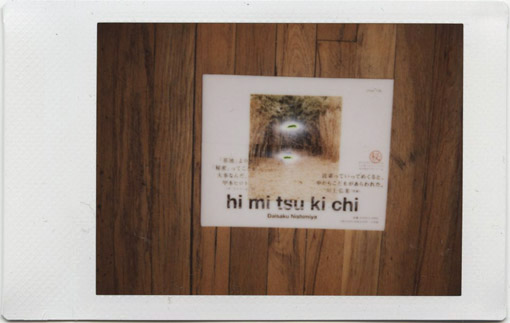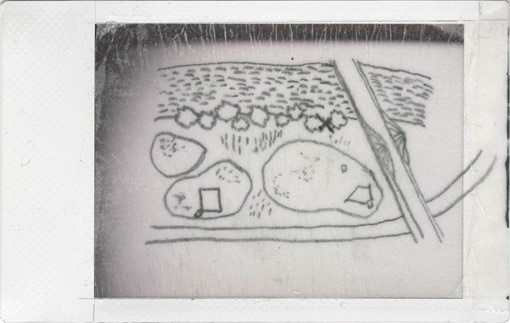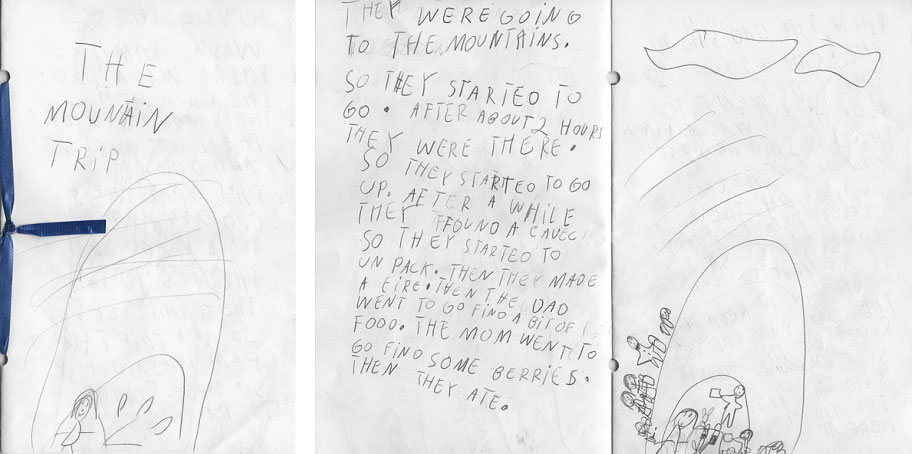I recently spent a month in Japan. I was there to make photos, but I also went to a lot of bookstores. Going into a bookstore in another country is complicated and quite funny since I was illiterate. My favorite find was a book titled, hi mi tsu ki chi, by Daisaku Nishimiya. Daisaku Nishimiya walked around Tokyo photographing children’s secret fortresses.

Along with these photos Daisaku Nishimiya also includes an aerial drawing of the location

I asked Daisaku Nishimiya a few questions about his work.
Carrie Thompson: Tell me a little about yourself, are you a full-time photographer? What projects have you made other then hi mi tsu ki chi?
Daisaku Nishimiya: Yes, I am a full-time photographer. The projects I have made other than hi mi tsu ki chi are “a man” in 2004 and “mocktail” in 2007. (see photos here)
CT: Can you tell me what hi mi tsu ki chi means in English?
DN: Well, “hi mi tsu ki chi” signifies “a secret and precious place” and also “a secret place only for me, or for us”. Literally, himitsu means a secret, and kichi means a base in Japanese. For children, himitsu kichi means a secret fortress or a secret hiding place.
CT: Why did you decided to make a book a children’s secret fortresses?
DN: I remember the feeling of deep emotion at the moment when I heard the word “himitsu kichi.” It awakened many memories, colors and scenes of my childhood, which must have become obscure and may be a fantasy I felt as I have grown up. I was deeply moved. The sound of the word “hi mi tsu ki chi” excited my imagination. If children of today, especially those in a large city of Tokyo, are still creating himitsu kichi, I want to record them with photos.
CT: When you were young did you have a secret fortress?
DN: Yes, I did have a secret fortress when I was a child. I think it was certainly nothing great like the ones seen in my book. Yet, it must have been a precious and comfortable place.
CT: I really enjoy the drawings in the book, did do the drawings? Why did you decide to add these drawing to the book?
DN: Adding the drawings of maps was the idea of the editor of the book. The book is made up of a combination of a photo of a scene in which a secret fortress is hiding and that of the secret fortress itself. It seemed nice to add a drawing of a map for each scenic photo to show the place of a secret fortress and marking with X. We (the editor, the art director and I) discussed size and density of each map as well as its position to be put in a page. We had the designer redraw the drawings from my rough sketches. I am glad that you enjoy the drawings, which I also enjoy.
CT: Can you tell me what you are working on now?
In my usual activities, I always take a photo of whatever appeals to me. Photos of any genre; snaps, portraits, natural scenes, etc. I have recently been taking photos of “kids, children” and “scenes of Tokyo and its suburbs” a lot. I would be very happy if I could connect various photos I am taking with a theme as I have done in “hi mi tsu ki chi”.
You can find hi mi tsu ki chi here and here
and more images here

 At a recent visit to Dashwood Books I picked up their lovely self-published book, Carl Johan De Geer’s Long Live the Large Family. I was excited to feature this excellent book here, but 5b4 beat me to the punch.
At a recent visit to Dashwood Books I picked up their lovely self-published book, Carl Johan De Geer’s Long Live the Large Family. I was excited to feature this excellent book here, but 5b4 beat me to the punch.








